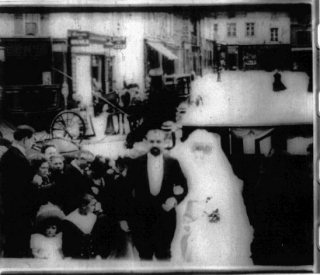Date: 7 November 2000 | Season: Ken Jacobs Nervous System
KEN JACOBS’ NERVOUS SYSTEM
Oxford Phoenix Picture House Cinema
Tuesday 7 November 2000, at 7pm
CRYSTAL PALACE
Ken Jacobs, USA, 1997, Nervous Magic Lantern, b/w, sound, c.25 min
Impossible movements … impossible spaces … issue forth from a single, somewhat unusual slide projector (of British manufacture) employed in an unexpected way. Cinema without film or electronics. And, as with The Nervous System (utilising pairs of projectors), depth phenomena is produced that can be seen as such without special viewing spectacles, and even by a single eye. (Ken Jacobs)
COUPLING
Ken Jacobs, USA, 1996, Nervous System, b/w, sound, c.60 min
Lumiere Brothers 1896 / Ken Jacobs 1996
A wide Paris street lined with small shops. Horse carriages and passers-by move freely about (there seem to be no designated traffic lanes). A wedding procession mounts church steps, advancing towards the camera. Their ascent remains stately throughout, if also spatially delirious. In keeping with the mystery of the nuptial sacrament, the bride in white – creature of light, of white movie screen – is allowed only a hint of facial features. Her older brother escorts her, the groom follows. The brother is Charles Molsson, the Lumiere machinist that built their first camera and hand wound the projector at The Grand Café, place of their first public screening. It is more than likely that this is the first wedding movie. (Ken Jacobs)
This performance was made possible thanks to the support of the Museum of Modern Art, Oxford. Thanks to Kerry Brougher of MoMA and all at British Screen and Picture House Cinemas.
FURTHER NOTES
SPATIAL / TEMPORAL PLASTICITY IN KEN JACOBS’ NERVOUS SYSTEM FILM PERFORMANCES
“21/2 D” is hard to conceive. Things should be either flat or in depth. Yet the lit rectangle doubly cast by The Nervous System evidences, embroiled together obscenely, the flat – the usual illusion of forms reshaping as they slide across the screen, one with the screen – and the deep – here the screen fragmented perpendicular to the line of view, its surface seemingly divided among myriad objects reaching forward and back of the actual plane of focus – and something in-between, with both flat and deep claiming appearances unto their respective realms. Things get twisted, caught in this tug-of-war. It’s The Nervous System, putting the tangle into rectangle, and leaving it a wreck. (The contemplation of it strains our brains.)
Not only things pictured but the rectangle itself is caught in the struggle and becomes spatially unstable, advancing or sinking in depth, stretching or compacting, leaning, tilting, swinging, rising, falling, splitting, peeling off the screen. The rectangle itself in motion becomes a creature of time.
“Time / motion” study hardly suggests the exercise in ecstasy this can be. Or that we’re touching on the essence of cinema, its original impetus. I’ve returned to that place (not alone) after a near-century of cinema “rationalised”, mechanically standardised, phenomenologically fixed, to at last and at the least bring it abreast of the development in the visual arts known as cubism. I think it’s about time.
Toying with light, with phantasm, can also open time to fantastic changes. Temporal illusions of another order from the intellectual expansions/contractions of Griffith and Eisenstein, what were in fact literary understandings of time, intricacies of ordering only sometimes moving into modernist derangement and delirium, into the transcendent (rather than escapist) function of art. Explain a time … in which things race forward, with bursting velocity, moving, moving ever forward, and yet don’t cover an inch of space (time arrested while remaining time, i.e. with things in motion) … without the projectionist’s permission. Or perhaps as wheels clearly turn forward, legs stride forward, they do so while irresistibly moving backwards … direction and evolvement in time as well as space in the control of the cine-puppeteer.
Well, what moves the puppeteer ? The very specific possibilities inherent to a particular strand of film. This frame times that frame equals … it’s anyone’s guess until discovery of the exact formula of projection adjustments makes it happen, and often it’s an effect unique to that coupling, that formula. Control, then, is a matter of attending very closely to what’s on the film. One tries this and that, but the givens of the shot, and their impact on the performer-projectionist, swing the action.
(Ken Jacobs)
Back to top
